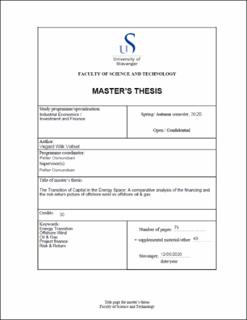| dc.description.abstract | This thesis analyzes the financing and risk-return picture for European offshore wind parks and compares it to offshore oil and gas projects. In order to do this, a three-step approach was used, where firstly financial data was gathered for a portfolio of offshore wind parks in Europe (n=47), which had a financial investment decision from 2014 to 2019. Secondly, from a subset of the portfolio (n=27), the return (IRR), was calculated by creating a simplified valuation model in order to assess the risk-return picture. Thirdly, the risk-return picture was then compared to offshore oil and gas, by evaluating the return (IRR) for a portfolio of European offshore oil and gas projects (n=35) which had a financial investment decision from 2010 to 2019. This was supplemented by qualitative data, in the form of semi-structured interviews, where financial actors were interviewed on the financing aspects and risk-return picture of offshore wind.
This study finds that offshore wind is attracting significant investment interest as a green, low-risk investment. It is further benefiting from the fact that there is currently a lack of alternative low-risk investment opportunities as the interest rates are low or negative. Project finance is the prevalent source of financing in offshore wind. A possible reason being that it can gain companies access to cheaper financing and financing facilities specifically tasked with ESG type investments, whilst simultaneously improving their perceived returns through leveraging. This is especially true for companies who have their core industry outside the offshore wind space i.e. oil and gas companies.
The study also shows that offshore wind projects which managed to secure high subsidies have the highest returns. However, given the competitive nature of the offshore wind space, the subsidies have been decreasing and the offshore wind parks scheduled to start up in mid-2020 have a lower return picture. Comparing this to the oil and gas industry, which has experienced high returns in the same time period, the study finds that the risk-return picture between the two industries are fundamentally different and a lower return for offshore wind must be expected. However, the low risk of offshore wind is underpinned by subsidies guaranteeing the price, and as such, the future risk picture of offshore wind in Europe is uncertain as the subsidies are decreasing.
A number of oil and gas companies have entered the offshore wind market. In addition to the benefit of cheaper financing mentioned above, they also benefit from; diversifying their energy portfolio, lowering their overall risk picture whilst simultaneously ‘green-washing’ their image. It seems likely that offshore oil and gas companies are also attracted to the offshore wind market due to the clear synergies between the industries. However, the data analysed here has illustrated that such gains are yet to be realized, at least for bottom-fixed offshore wind parks. | en_US |
